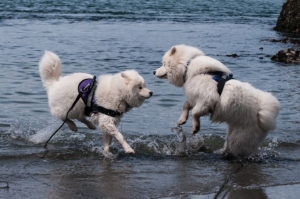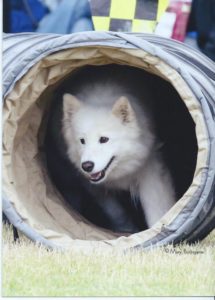First Aid Kit For Dogs
by Cheri Hollenback
Despite the questionable weather, the calendar is telling us it’s springtime. Along with spring, most of us look forward to increased travels with our dogs. With that in mind, our esteemed editor, Liz asked to me to write some suggestions on summertime travel first-aid kit.
For a basic kit that should cost no more than $25.00, I would suggest a plastic container that seals and is big enough to hold a 6-pack of pop. Include the following items:
1. Ace bandage
· For holding a splint or bandage in place or as a pressure dressing
2. Baggies
· Zip- & tie-close; small & large sized
· Ice packs or heat packs with a warm, wet washcloth inside
3. Bulb Syringe
· Preferably sterile, can be used to irrigate wounds with sterile water or Hydrogen Peroxide or administer Hydrogen Peroxide to induce vomiting.
4. Crazy glue
· Thanks to Don Duncan, I’ve come to appreciate this item’s wonderful usefulness for closing lacerations. If the wound is cleaned out and not a bite, a thin bead of glue on either edge of the wound then holding the edges together until the glue affixes will do the trick!
5. Gauze roll
· 2″ or 3″ width
· Can be used for bandaging or serve as a muzzle in a pinch
6. Gauze pads or non-stick gauze pads
· 3×3 or 4×4; sterile
7. Hydrogen Peroxide
· For cleaning wounds and as an emetic
8. Medications
· Aspirin (baby) (2 for adults, 1 for puppies)
· Bacitracin or similar antibiotic ointment
· Imodium A-D or Pepto Bismol
· Petroleum jelly (Vaseline)
· Benadryl (sealed pills)
9. Penlight or small flashlight
10. Scissors
11. Sock (cotton tube style)
· Hold bandages in place on an extremity
12. Sunblock
· For nose or light skin
13. Tape, plastic first aid
14. Thermometer
· Electronic — the mercury ones will overheat in the heat of a closed car and become unusable
15. Tweezers
16. Vetwrap
Other items that I would recommend carrying, but may exceed the capacity of the box include a quart or more of water, and a light blanket. The blanket can be used as a sling to carry an injured animal. It can also be placed over a frightened, injured animal so you don’t become a bite victim yourself. Another consideration is that many of the items in your kit can also be used for humans — as long as they’re new! 😉
Paperwork you may want to keep in the glove box could include vaccination records (including a rabies certificate — who knows when you’ll get a whim to head to Canada — or head off to a show and inadvertently leave them behind?), the names and dosages of any medications your dog is on and your regular vet’s contact information. It may also be helpful if you and your dog are parted to have identification information for your dog, including a recent photograph, tattoo and/or microchip number.
For more information, Pam Barbe has some wonderful links from her website (Click Here to see it in a new window).
So you know what to do with these items, I would also highly recommend the American Red Cross course on Pet First Aid. For more information, contact your local chapter of the American Red Cross.







